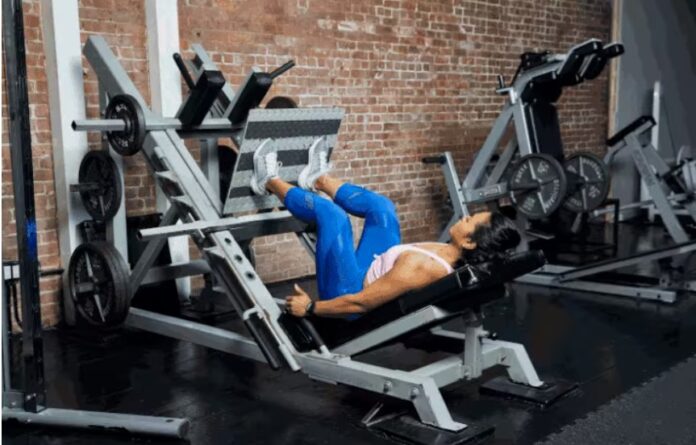A common piece of equipment in gyms, the leg press helps develop important leg muscles. There are two leg press machines commonly found in gyms and home gyms: the standard horizontal leg press and the 45-degree leg press, with a seat that reclines at an angle while your legs press upward in a diagonal direction.
Both machines develop the quadriceps and hamstrings of the thigh and the gluteus (buttocks). While it seems like a simple exercise, it’s essential to learn how to use it properly. Paying attention to your form can maximize the strength-building benefits and prevent injury. The leg press is used as part of a leg strengthening routine or a machine circuit workout. How to Do the Leg Press
Leg Press Benefits
The leg press machine allows you to get some of the benefits of a barbell squat for developing the quadriceps. Secondarily, It strengthens the hamstrings, calves, and gluteus maximus.
One benefit of the leg press machine is that you can emphasize different muscles by varying your leg press foot position. It builds strength in these muscles, and you can use it to overcome imbalances, such as overly developed hamstrings, compared to quadriceps. How to Do the Leg Press
Although the leg press mimics the barbell squat, it reduces the force on your core, making it less of a full-body exercise. This can be beneficial if you add the leg press to your routine as an accessory to squats. Doing so will allow you to continue adding volume to your quadriceps and other leg press muscles worked without causing the additional fatigue that loading a barbell on your spine creates.
Further strengthening your quadriceps can boost your squat performance by increasing strength in the muscles needed to progress. If you find you have reached a strength plateau with your barbell squat, The leg press could be added to help.
Enhancing your stability and balance can also be achieved by using a sitting leg press machine. especially if you are a beginner at lifting heavy weights. Some people are not ready to use a barbell for squatting until they are accustomed to lifting heavy weights with their legs in a way that increases balance and stability of the core and legs in a safe manner, such as with the leg press.
Step-by-Step Instructions
When you sit down at a seated leg press machine, your body should be in a particular position. Sit on the machine with your back and head resting comfortably against the padded support. Place your feet on the footplate about hip-width apart while ensuring that your heels are flat. How to Do the Leg Press
Your bottom should be flat against the seat rather than raised. Your legs should form an angle of about 90 degrees at the knees. If your feet are too high on the plate, it will stress your glutes; too low puts unnecessary pressure on your knees. Your knees should not be bent inward or outward; instead, they should be parallel to your feet.
As you press, make sure to keep this alignment. Grasp the assist handles to provide support and keep your spine and head in position.
- Brace your abdominal muscles and push the platform away with your heels and forefoot. Your heels should remain flat on the footplate. The front of your foot or toes should never be used exclusively to move the pad forward.
- While exhaling, extend your legs and keep your head and back flat against the seat pad. Extend with slow control rather than with an explosive movement.
- Pause at the top of the movement. Do not lock out your knees, and ensure that they are not bowing out or in.
- While inhaling, return the footplate to the starting position by gradually bending the knees. Keep the feet and back flat throughout.
- If you have never done leg presses, start modestly with three sets of 10 leg presses. You can advance from there as you build strength. How to Do the Leg Press
Leg Press Common Mistakes
It is essential to ensure proper form to get the most out of your leg press routine. To ensure you are doing the leg press safely, avoid these errors.
Too Much Weight
One of the most significant factors is ensuring you’re not trying to lift more weight than you should. If you can’t control your movements, you must reduce the weight. Proper form is more important than the amount of weight you’re lifting.
Buttocks Not Flat Against Seat
If your buttocks are raised off the seat, your legs are at too sharp of an angle. You will need to move the seat back until your knees and buttocks are comfortably positioned. You can recognize poor positioning when you feel cramped, and/or your knees seem to be directly in front of your eyes. How to Do the Leg Press
Placing Hands on Knees
Placing hands on the knees is a common mistake that will break your form. Grip the assist handles instead.
Short Range of Motion
Always follow through the entire range of motion without lifting your hips. If needed, adjust the seat and/or lower your weights. This means getting deep into the position with your butt below your hips, and your knees wide.
Raising Head
Focus on the position of your head. It should be steady and laid comfortably against the seatback. If you are jerking your head forward, you are using too much weight.
Breathing
Remember to keep breathing during the effort phase and to avoid holding your breath. If you focusing on exhaling on exertion and inhaling on release, your breathing will eventually become automatic. How to Do the Leg Press
Leg Press Modifications and Variations
You can adjust the leg press to make it more accessible as a beginner and to use it to progress.
Need a Modification?
You need to adjust this very individual exercise to fit your body. As machines can vary, Before beginning, you might wish to ask a trainer to demonstrate how to modify it safely. How to Do the Leg Press
Beginners should use lighter weights and develop good form. Concentrate on slow and deliberate movements rather than how many reps or the amount of weight you’re lifting. Ask a trainer to review your form and get personalized advice if you notice any unwarranted stress or pain.
Up for a Challenge?
Foot positioning can be used to work muscles in different ways. Using a wider foot placement will work the inner thigh muscles. Using a narrower foot placement will work the outer thigh muscles.
Placing your feet higher on the footplate will work your gluteus maximus and hamstrings to a greater degree. Placing your feet lower on the footplate will emphasize the quads more, but this also puts more stress on the knees and should be done with caution. How to Do the Leg Press
You can also use the leg press one leg at a time if you are working to overcome imbalances.
Safety and Precautions
Avoid the leg press if you have weak pelvic floor muscles, as it puts much stress on the pelvic floor. You should not use this machine if you have a knee injury. Rather, perform safer leg press substitutes or strengthening exercises per the advice of your physician or physical therapist. How to Do the Leg Press
Do not push through the pain if one or both of your knees hurt. Pushing through will only cause injury. This exercise can also place stress on your back, so it should be avoided if you have a back injury or back pain.

